Recent viewing, May-June 2016, part two
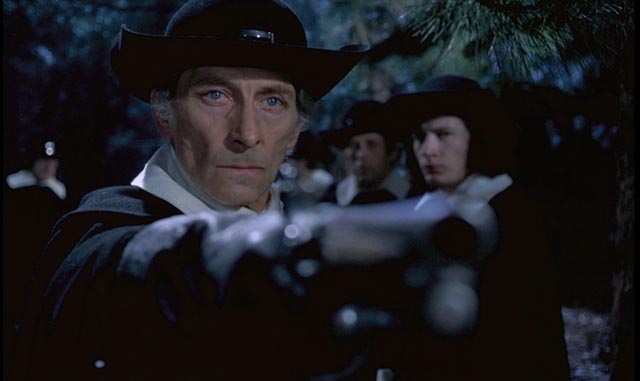
Nazis and vampires have been popular exploitation subjects for decades, turning up in a range of genres from the Gothic to epic SF and paranoid b-movie thriller. Without any particular intention, I’ve caught up with several films recently that deal with both menaces – well, in the case of Nazis, only indirectly.
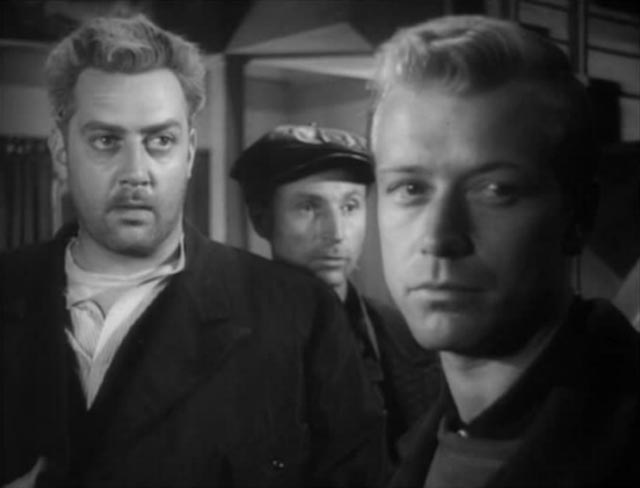
Oblique Nazis
William Cameron Menzies was one of the great production designers. In fact, he invented that particular job; previously the artists who created the look of sets were called art directors. But Menzies went much further, designing lighting, camera set-ups, and even directing elements of such movies as Gone With the Wind. As a director, however, he had limitations.
Menzies had an amazing eye for visual composition, creating images in depth, combining looming close-ups with action and figures in the deep background, often distorting space to create a nightmarish effect (particularly notable in Invaders From Mars [1953]). But he had at best a weak sense of drama and showed little talent for working with actors. As a result, his own films remain largely interesting for their look rather than their storytelling.
The Whip Hand (1951) is a minor work relative to his best films (Invaders and Things to Come [1936]). But its convoluted history makes it interesting despite its failings. Made in the late ‘40s, it was held back by producer Howard Hughes for several years, and eventually partially re-shot and re-edited because just a few years after the end of the war the story’s original villains no longer seemed relevant.
The script originally had an American reporter getting stuck in a small, isolated Minnesota town where he gradually uncovers mysterious doings at a large nearby estate. The town has essentially been taken over by Nazis who are plotting the rise of a new Reich, their first objective being the release of deadly bacteria into American waterways. The movie was one of the earliest examples of two sub-genres: the lingering Nazi threat (most notably exemplified by Marathon Man and The Boys From Brazil, although there are many other examples: Run for the Sun [1956], The Frozen Dead [1966], Shock Waves [1977], and so on) and the biological warfare menace (a la The Satan Bug and The Andromeda Strain, among others).
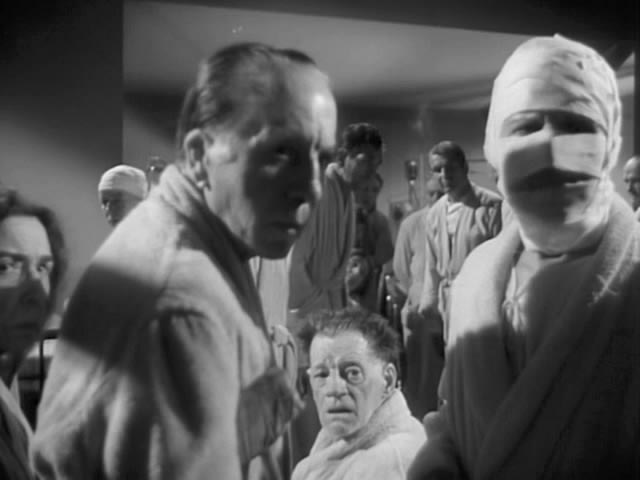
But with the war over, Hughes figured nobody would care about Nazis; there was a newer menace to be exploited. So the film was revised to make the bad guys Commies. This change undermined the original’s big moment when hero Matt Corbin (Elliott Reid) would have spotted none other than Hitler himself on the estate’s patio. Now the foreign agents are a fairly insipid bunch. Worse, a tacked on prologue (in Russian!) explains the whole plot before we even meet Corbin, so we know well before him what’s going on … which makes him seem pretty dumb as everyone in town drops endless menacing hints which he doesn’t pick up on.
The cast is mostly undistinguished B-movie contract players, although Raymond Burr does manage to breathe a little life into his innkeeper, using a forced good-humour to convey threat in apparent friendliness.
The essentially naturalistic setting reins in Menzies’ visuals, leaving little room for the kind of expressionism which characterizes Invaders From Mars, The Maze and Things to Come, but nonetheless The Whip Hand does have its share of striking compositions and he manages to create a bit of paranoid atmosphere in the town.
For such a minor film with such a ragged history, the print used by Warner Archive for their DVD is in surprisingly good shape, soft in places but with effective contrast and decent black levels.
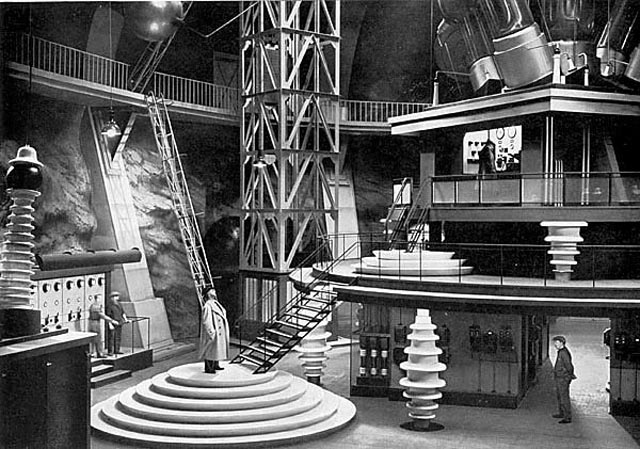
Made at the dawn of the Nazi period, Karl Hartl’s Gold (1934) can’t be said to conceal the Fascists the way Hughes did in The Whip Hand. The tight grip of the Party hadn’t quite closed on the German film industry when this expensive production was mounted, and yet certain attitudes which underscored Nazi ideology are apparent here.
Although not made on the scale of Fritz Lang’s silent science fiction epics, the design of Gold was obviously influenced by those films, as is the fascination with massive machines which dwarf the characters. The tone is one of damaged national pride and apocalyptic retribution.
Professor Achenbach (Friedrich Kayssler) has invented a machine which uses massive amounts of power to transform lead into gold. When a saboteur destroys the machine at its inaugural demonstration, the Professor is killed, his theories officially unproven. His assistant, the engineer Werner Holk (Hans Albers), is lured away by John Wills (Michael Bohnen), a rich English industrialist, to oversee his own installation, which turns out to be a much bigger duplicate of Achenbach’s project, built from stolen plans. Holk is conflicted: if he can succeed with Wills’ machine, then he can vindicate Achenbach. But if he helps Wills, then he is betraying his own country.
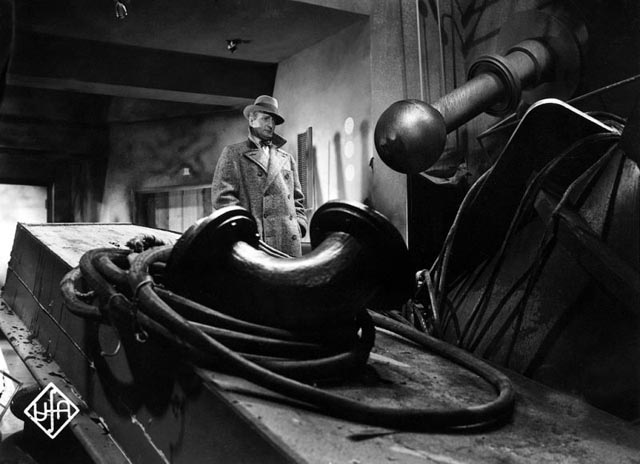
There’s a mild, under-developed complication in Wills’ daughter Florence (Brigitte Helm), who falls for Holk, though he’s firmly attached to Margit (Lien Deyers), his fiancee back home, an attachment literally sealed by blood as she provided some of her own in a transfusion to save Holk’s life after the explosion which killed Achenbach.
As in many films from the Nazi period, the English appear as unscrupulous capitalist villains (as in Herbert Selpin’s Titanic [1943], where it’s the decadent corruption of the owners and builders of the famous ship who are responsible for its destruction). Germany here is the victim of those who defeated it in World War One and then crushed it economically in the aftermath. German brains and ingenuity are capable of great technological innovation, only to have it stolen from them. The bitterness about Versailles and the crippling war reparations which were dictated by the treaty are embedded in the narrative fabric of Gold, and the myth of blood which was so central to Nazi ideology is explicitly evoked by the bond between Holk and Margit.
Karl Hartl lacks Fritz Lang’s ability to create monumental effects that raise sometimes creaky stories to the level of myth, but there’s no denying the impressive production design of the great transmutation machine, a multilayered lab through which vast bolts of electricity rip. The melodrama serves its purpose, but the film never addresses a huge fundamental flaw at its centre: although Wills claims that his aim is to make everyone in the world equally rich with his industrially created gold, there’s no way that this could be the outcome. Gold has value in direct proportion to its rarity, so if everyone has a pile of it, it becomes worthless.
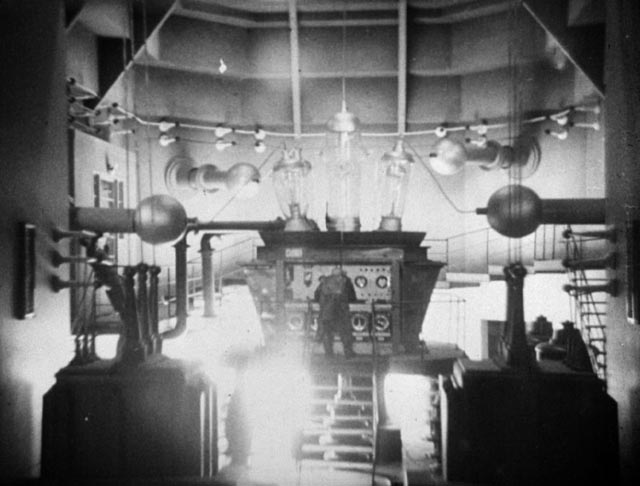
The filmmakers are aware of this because after the experiment proves successful, economic panic engulfs the world, crashing stock markets. The machine, in the venal hands of the evil English industrialist, turns out to be a powerful weapon for the destruction of society. Which begs the question, what was Achenbach’s intention when he developed the process? Was he a purely theoretical scientist, merely proving a theory? If he had been successful, wouldn’t it have been a German who created global panic instead of an unscrupulous Englishman?
The film avoids having to address these questions by climaxing with a spectacular explosion.
The Kino Blu-ray sports a restoration by the Murnau Foundation, but the print is still a bit rough. Nonetheless, it’s great to see yet another previously impossible-to-see movie surface like this. A pity there are no supplements. A commentary, or at least an interview with a film historian who could illuminate the context of the production would have been greatly appreciated. (Though I haven’t had a chance to see it yet, Kino has also released Curt Siodmak’s The Magnetic Monster, a 1953 B-movie which cannibalized Gold for its lab and effects sequences.) Now, maybe someone will revive Hartl’s other big SF movie, F.P.1 Antwortet Nicht (1932)[1], about a gigantic floating airport built in the mid-Atlantic to facilitate long-range flying.
*
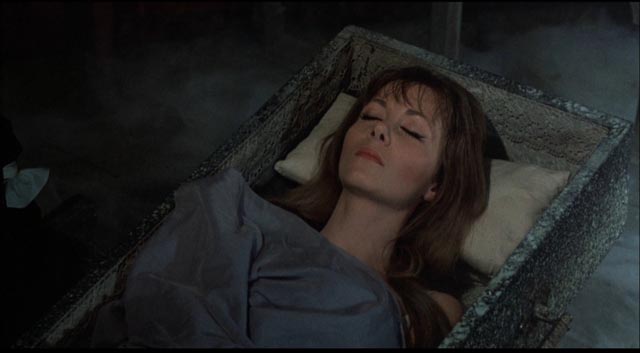
Hammer Twins
Towards the end of the ‘60s Hammer Films had started to flounder. While their Technicolor horrors had redefined the genre in the late ‘50s, inspiring the explosion of Italian Gothics and Roger Corman’s Poe cycle in the States, a decade later their output seemed stale and dated – how could the caped blood-sucking count and the mad doctor compete in a world in which the Living Dead had been unleashed on contemporary society? Around the turn of the decade, the studio tried a number of things to retain its foothold, some more successful than others.
When Dracula was dragged into the present, the results were pretty dire: the Count was afraid to leave his house in Dracula A.D. 1972 (Alan Gibson, 1972), not without reason as London was populated by tediously swinging young adults. There were 19th Century-style adventures (The Vengeance of She, The Lost Continent), caveman epics (When Dinosaurs Ruled the Earth, Creatures the World Forgot), science fiction (Moon Zero Two, an embarrassment from the studio which had brought the Quatermass stories to the big screen), even lowbrow comedies adapted from television (On the Buses, Love Thy Neighbour, Man About the House).
And then there was a development made possible by the decade’s loosening censorship rules: sex. Where the older horrors, for all their blood and gore, had a kind of classical elegance, Hammer plunged rather self-consciously towards the exploitation of bare flesh in many of their later releases. Sometimes this even resulted in works which were more than merely gratuitous: Dr. Jekyll and Sister Hyde (Roy Ward Baker, 1971), although it sounds like a porn riff on Stevenson’s classic, actually has a smart script by Brian Clemens and does some interesting things by playing with gender roles.
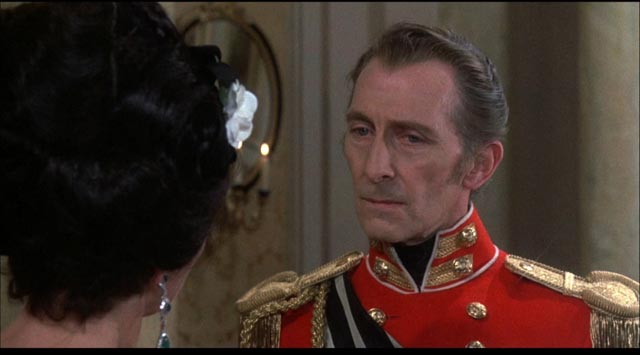
The previous year, Baker also directed the first of what came to be known as the “Karnstein trilogy”, although the three films are really not connected other than through that family name and a very loose connection to Sheridan Le Fanu’s brilliant novella, “Carmilla” (1872), the first great vampire story in English literature (preceded chiefly by John Polidori’s fragment “The Vampyre” [1819] and the epic penny dreadful Varney the Vampire, or The Feast of Blood [1845-47], variously attributed to James Malcolm Rhymer or Thomas Peckett Prest. The latter, although of dubious literary value, introduced most of the tropes we now take for granted in the classic – as opposed to Twilight – vampire tale).
“Carmilla” is the story of a family victimized by a predatory female vampire who insinuates herself into various households in order to prey on young daughters. Richly atmospheric, elegantly written, it is also quite explicit in its lesbian undercurrents, with a rigid patriarchal order virtually helpless against the power of female sexuality. This latter element makes it an ideal source for exploitation (although it was more or less suppressed in the two major preceding adaptations, Carl Dreyer’s Vampyr [1932] and Roger Vadim’s … et mourir de plaisir [aka Blood and Roses, 1960]).
It’s interesting to note then that most of the people involved in the production of The Vampire Lovers (1970) deny it altogether. Star Ingrid Pitt sees her predatory character simply as someone trying to make an emotional connection; director Baker finds the whole idea that there could be a lesbian element ridiculous because the source is a Victorian story written by a Protestant Irishman. I’m not sure why they feel these denials are necessary, other than that in 1970 lesbianism was still seen to be “deviant” and therefore mention of it had to be avoided. The film after all is loaded with girl-on-girl play in skimpy outfits.
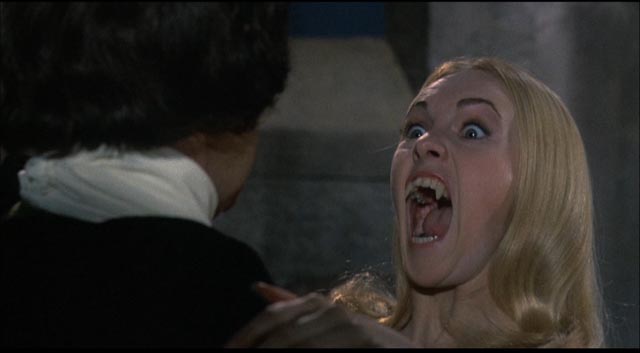
As John-Paul Checkett points out in his lengthy article about the history of Carmilla on film in Video Watchdog #183 and #184, the screenplay by Tudor Gates essentially inverts Le Fanu’s story, making the vampire Mircalla subservient to a vaguely sketched male master and transforming the author’s ineffectual patriarchs into strong and decisive suppressors of female sexuality.
Baker’s direction lacks the Gothic vigour of Terence Fisher’s approach to the earlier Dracula (1958), but The Vampire Lovers is fairly atmospheric and its two female leads give engaging performances; although Ingrid Pitt was really too old for the part of Mircalla/Carmilla, she fully invests in the character, while Madeline Smith is charming as the vampire’s prey.
The colours on Shout! Factory’s Blu-ray are a bit dull and the contrast not as strong as it could be, but overall the film looks and sounds quite good. Most if not all the extras come from an earlier DVD edition: a commentary with director Baker, writer Gates and star Pitt, which is the main source for their denials of any lesbian content; a brief featurette about the production; an interview with Smith; and Pitt reading excerpts from Le Fanu’s story.
Two more Karnstein movies were rushed out after the unexpected success of The Vampire Lovers, the first a bit of a disaster; Lust for a Vampire (1971), released just three months after Baker’s movie, was again written by Gates, but directed by long-time Hammer writer Jimmy Sangster, who had insufficient time and budget to do much more than reiterate the first film with a greater emphasis on the sex. The third part of the “trilogy”, however, was the best. Directed by John Hough, it took off in a different direction despite again being scripted by Gates.
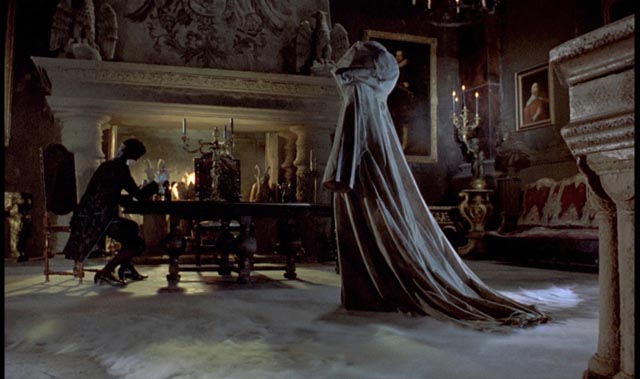
Twins of Evil (also 1971) moves even farther from the source, instead drawing on another sub-genre, incorporating elements from Witchfinder General (1968), Mark of the Devil (1970), and Blood on Satan’s Claw (1971). Here vampires are mixed with Puritan witch-hunters, lead by Gustav Weil (Peter Cushing) who has made it his mission to crush female sexuality wherever he finds it, rampaging with his followers around the countryside to find and burn any woman who lives alone and dares to enjoy sex.
Into this dire household come the twins of the title, Maria and Frieda Gellhorn (played by twin Playboy centrefolds Mary and Madeleine Collinson), Gustav’s recently orphaned nieces. To complicate things, there’s a vampire in the neighbourhood, Count Karnstein (Damien Thomas), who’s putting the bite on the local peasants. While Maria does everything she can to placate the perpetually angry Gustav, Frieda wants to rebel, and what better way than seeking out the Count and voluntarily becoming a vampire. Needless to say, the fact that the girls are identical twins complicates things. Maria’s attempts to protect Frieda by covering for her end up by making it appear that she herself is the bad one, with Gustav determined to destroy her. Frieda is quite happy to see Maria die in her place, but heroic Anton Hoffer (David Warbeck) races to the rescue and Gustav is forced to face his own destructive evil streak.
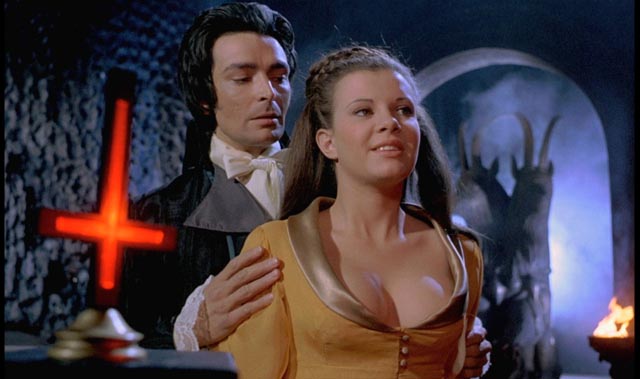
Twins of Evil has more style and energy than the two earlier movies and stands as one of the last really worthwhile Hammer films, up there with Vampire Circus (1972) and Captain Kronos – Vampire Hunter (1974). And fittingly Synapse gives it a terrific presentation on Blu-ray, with a rich and vibrant transfer and substantial extras, including a feature-length (1:24:36) documentary about the making of the film, a lengthy featurette about a collection of Hammer props and miniatures (23:28), a stills gallery, a deleted scene, isolated music and effects track, and trailers.
____________________________________________
(1.) Kino did release F.P.1 Antwortet Nicht on Blu-ray in August 2021 in both its original German version and the much shorter English-language cut, along with a commentary. (return)
Comments